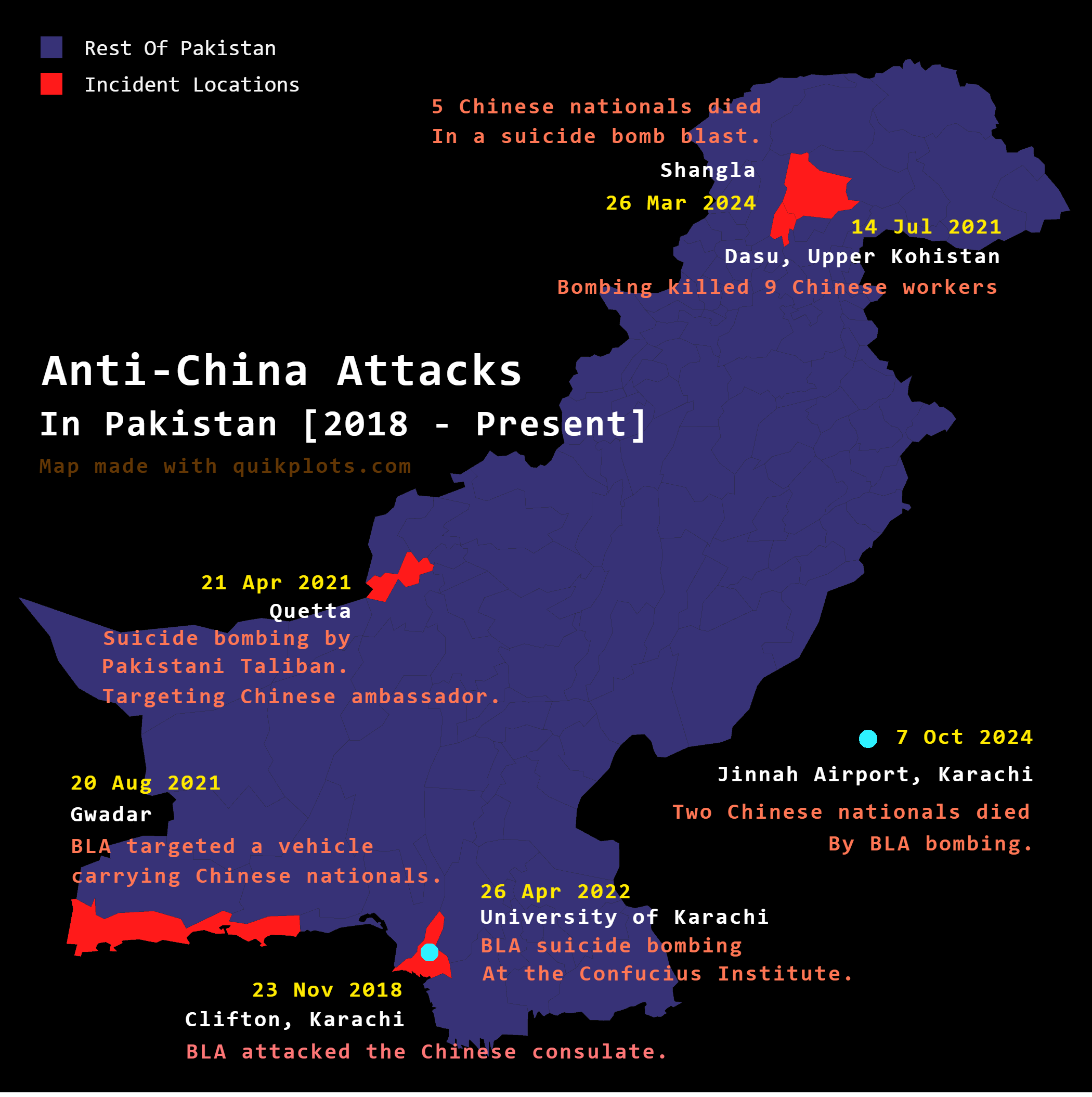Map of Anti-China Attacks in Pakistan


David Chen
Data Visualization Specialist
David Chen is an expert in transforming complex geographic datasets into compelling visual narratives. He combines his background in computer science ...
Geographic Analysis
What This Map Shows
The 'Anti-China Attacks in Pakistan' map depicts a troubling trend of targeted attacks against Chinese nationals in Pakistan from 2018 to the present. The map visually highlights the locations where incidents have occurred, primarily focusing on regions like Balochistan, where the Baloch Liberation Army (BLA) has been particularly active in its campaign against perceived Chinese influence. This visualization serves as a stark reminder of the complexities surrounding international relations in South Asia, especially in the context of Pakistan's strategic partnership with China.
Deep Dive into Anti-China Sentiment in Pakistan
The relationship between Pakistan and China has been historically strong, characterized by deep diplomatic ties and significant economic investments, especially through initiatives like the China-Pakistan Economic Corridor (CPEC). However, the presence of multiple terrorist groups in Pakistan has led to a paradox where foreign nationals, particularly Chinese, become targets amid a backdrop of local grievances. One of the most prominent groups involved in these attacks is the BLA, which seeks greater autonomy for the Balochistan region.
Interestingly, the BLA views Chinese investments as a continuation of historical exploitation in Balochistan, where locals feel marginalized and ignored. This sentiment has resulted in a series of attacks aimed not only at Chinese workers but also at the larger framework of foreign involvement in the region. From 2018 onwards, the BLA has conducted numerous assaults, raising questions about the safety of foreign investments in Pakistan.
Moreover, the Taliban has also claimed responsibility for attacks against Chinese nationals, further complicating the situation. Their hostility stems from a broader ideological opposition to foreign influence and a desire to assert control over regions they consider strategically important. The motives behind these attacks can often appear nebulous, driven by a combination of local grievances and a broader anti-foreign sentiment.
Statistics show that these incidents have not only increased concerns for Chinese nationals operating in Pakistan but have also led to greater security measures and military presence in affected areas. The Pakistani government has been under pressure to ensure the safety of foreign investors, which is crucial for economic stability, especially given the current economic challenges facing the country.
Regional Analysis
When we break down the map by regions, Balochistan emerges as the epicenter of anti-China attacks. This province is not only rich in natural resources but also strategically located, making it a focal point for both domestic and foreign interests. Cities like Gwadar, which is critical to the CPEC, have seen a marked increase in security protocols due to threats against Chinese workers.
In contrast, other regions such as Sindh and Punjab have witnessed fewer incidents. Interestingly, these provinces tend to have more stable political environments and are less affected by the separatist sentiments that characterize Balochistan. However, the proximity of these regions to Balochistan means that the ripple effects of violence can still be felt, leading to heightened security across the border areas.
Comparatively, Khyber Pakhtunkhwa has also experienced sporadic attacks, albeit fewer than Balochistan. The interplay of tribal politics and anti-state sentiments in these regions adds another layer of complexity to the security landscape, further complicating how foreign nationals navigate this terrain.
Significance and Impact
The implications of these attacks extend far beyond immediate security concerns. They point to a broader narrative about the challenges of foreign investment in politically volatile regions. As the CPEC continues to develop, the Pakistani government faces the dual challenge of fostering economic growth while ensuring the safety of foreign nationals who are integral to these projects.
Additionally, these incidents could influence China's foreign policy decisions, as it balances its economic interests with the safety of its citizens abroad. The ongoing unrest could deter future investments not only from China but also from other countries wary of the instability in the region.
As we look to the future, understanding the dynamics behind these attacks will be crucial. Will the Pakistani government succeed in addressing local grievances to stabilize the situation? Or will the ongoing tensions continue to mar the relationship between Pakistan and China? Only time will tell, but what is certain is that the map of anti-China attacks is more than just a visual representation; it’s a reflection of the intricate socio-political tapestry of South Asia.
Visualization Details
- Published
- September 26, 2025
- Views
- 42
Comments
Loading comments...